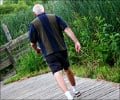A study at Indiana University has found that three easy - one could even say slow - 5-minute walks can reverse harm caused to leg arteries during three hours of prolonged sitting.

This study is the first experimental evidence of these effects, said Saurabh Thosar, a postdoctoral researcher at Oregon Health & Science University, who led the study as a doctoral candidate at IU's School of Public Health-Bloomington.
"There is plenty of epidemiological evidence linking sitting time to various chronic diseases and linking breaking sitting time to beneficial cardiovascular effects, but there is very little experimental evidence," Thosar said. "We have shown that prolonged sitting impairs endothelial function, which is an early marker of cardiovascular disease, and that breaking sitting time prevents the decline in that function."
The researchers were able to demonstrate that during a three-hour period, the flow-mediated dilation, or the expansion of the arteries as a result of increased blood flow, of the main artery in the legs was impaired by as much as 50 percent after just one hour. The study participants who walked for 5 minutes each hour of sitting saw their arterial function stay the same -- it did not drop throughout the three-hour period. Thosar says it is likely that the increase in muscle activity and blood flow accounts for this.
"American adults sit for approximately eight hours a day," he said. "The impairment in endothelial function is significant after just one hour of sitting. It is interesting to see that light physical activity can help in preventing this impairment."
The study involved 11 non-obese, healthy men between the ages of 20-35 who participated in two randomized trials. In one trial they sat for three hours without moving their legs. Researchers used a blood pressure cuff and ultrasound technology to measure the functionality of the femoral artery at baseline and again at the one-, two- and three-hour mark.
Advertisement
Source-Eurekalert









